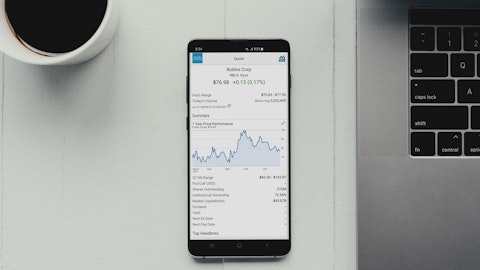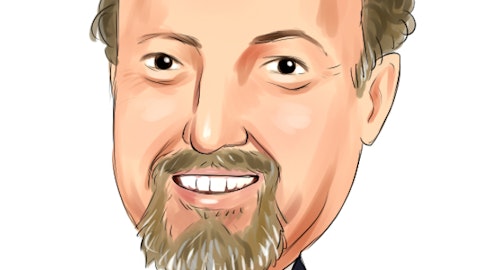Advance Auto Parts, Inc. (NYSE:AAP) Q3 2022 Earnings Call Transcript November 16, 2022
Advance Auto Parts, Inc. misses on earnings expectations. Reported EPS is $2.84 EPS, expectations were $3.34.
Operator: Welcome to the Advance Auto Parts Third Quarter Conference Call. Before we begin, Elisabeth Eisleben, Senior Vice President, Communications and Investor Relations, will make a brief statement concerning forward-looking statements that will be discussed on this call.
Elisabeth Eisleben: Good morning, and thank you for joining us to discuss our Q3 results. I’m joined by Tom Greco, President and Chief Executive Officer; and Jeff Shepherd, Executive Vice President and Chief Financial Officer. Following their prepared remarks, we will turn our attention to answering your questions. Before we begin, please be advised that remarks today will contain forward-looking statements. All statements, other than statements of historical fact are forward-looking statements, including, but not limited to, statements regarding our initiatives, plans, projections and future performance. Actual results could differ materially from those projected or implied by the forward-looking statements. Additional information about factors that could cause actual results to differ can be found under the caption forward-looking statements and risk factors in our most recent annual report on Form 10-K and subsequent filings made with the commission.
Now let me turn the call over to Tom Greco.

Copyright: zenstock / 123RF Stock Photo
Tom Greco: Thanks, Elisabeth, and good morning, everyone. Before we begin, I’d like to thank our entire Advance team and Carquest independent partners for their dedication throughout Q3, in particular, our teams throughout the Southeast who are still working diligently to get their communities back to normal after the damage caused by recent hurricanes. Our team always rises to the occasion in situations like this, and I could not be prouder of how we’ve helped others in a time of great need. We simply could not do what we do without our team’s unwavering focus on the customer. I’ll begin my remarks today with an overview of our Q3 performance and how we’re thinking about the balance of 2022. This includes the factors that led us to reiterate our full year guidance on net sales growth, comparable store sales and adjusted operating income margin while revising adjusted diluted earnings per share and free cash flow.
Based on the updated full year guidance we provided in our press release last night, 2022 will be our second consecutive year of sales growth and adjusted operating margin expansion on the back of our strong performance in 2021. We believe we’ll be one of very few retailers delivering back-to-back years of sales growth and adjusted operating income margin expansion. Secondly, I’ll briefly discuss some of the actions we’re taking in the fourth quarter. These actions reflect our analysis of year-to-date performance and were informed by our early thinking surrounding 2023. Finally, I’ll conclude with a review of the progress we’re making on primary strategic initiatives before turning the call over to Jeff. Starting with the third quarter. Net sales were up 0.8% and comparable store sales declined by 0.7%, in line with previous expectations.
As we’re expanding our footprint, new stores are providing incremental net sales growth. Increasing owned brand penetration is an important part of our margin expansion plans. However, owned brands have a lower price point, reducing net sales growth by 78 basis points and comp sales by 88 basis points in the quarter. In terms of category growth, batteries, fluids and chemicals as well as brakes were the top performers in Q3. Regional sales performance was led by the West, Mid-Atlantic and Florida. Both Pro and DIY omnichannel comp sales were in line with overall comp performance. Moving to profitability. We’re pleased that we were able to deliver a 98 basis point increase in our adjusted gross profit margin rate in Q3. This was primarily driven by our focus on category management, which is our largest initiative to drive profitable growth.
Strategic pricing initiatives and higher margin rates associated with owned brands were key enablers to adjusted gross profit margin expansion. In Q3, owned brands as a percent of total net sales were up nearly 230 basis points. SG&A costs were up 5.4% year-over-year, and given limited net sales growth, more than offset adjusted gross margin expansion in the quarter. Higher SG&A was primarily driven by inflationary costs. Overall, in Q3, adjusted operating income margin was 9.8%, which was down 68 basis points versus Q3 2021. As we lapped strong net income growth in Q3 2021, adjusted diluted earnings per share of $2.84 was down 11.5% versus the prior year quarter. Both GAAP and adjusted diluted earnings per share included a headwind of approximately $0.20 per share from foreign currency impacts in Q3.
Importantly, we continued to invest in the business while maintaining our strong commitment to capital stewardship by returning approximately $860 million in cash to shareholders through share buybacks and dividends during the first three quarters of 2022. Turning to guidance. There are a couple of factors which led to our updates in the press release yesterday. First, we reiterated full year guidance on net sales growth, comparable store sales and adjusted operating income margin rate. We revised full year adjusted diluted earnings per share to reflect both the foreign currency headwind in Q3, along with the estimated impact in Q4. Our full year guidance reflects an expansion of adjusted operating income margin and a range on adjusted diluted earnings per share growth of 5% to 6%.
This is on top of a 48% increase in 2021 versus 2020 on a comparative 52-week basis. Secondly, we revised our free cash flow outlook for the year to a minimum of $300 million due to updates in our working capital assumptions primarily related to inventory. Jeff will further outline the drivers of these changes to our free cash flow guidance later. While our full year 2022 guidance affirms that we believe we will expand margins, we’re lagging the market in top line growth in 2022. We’re not at all satisfied with this outcome as it’s inconsistent with our target of growing at or above the market over the long term. As we develop plans for 2023 and beyond, we’ve done a deep dive on the competitive environment and the actions necessary to accelerate growth.
From our analysis, two opportunities came to the forefront, particularly in the professional sales channel. First, we have opportunities on availability in certain categories, which require inventory investment to enable us to get more SKUs closer to the customer. Secondarily, while our research has consistently indicated that price is not the most important driver of choice for professional customers, we’ve tested and will make surgical pricing actions in certain categories to enable us to better address changes in competitive pricing dynamics. We believe of these two, the targeted inventory investment is by far the most important step needing to set us up for improved top line performance and share gains in 2023. As you know, 2023 will be the final year of a three-year strategic plan we outlined in April ’21 that focused on growing at or above market, expanding margins and returning excess cash to shareholders.
See also 15 Most Hated Companies in the US and 30 Wealthiest Families in the World.
We established three-year performance ranges for several financial metrics and an overarching goal of delivering top quartile total shareholder return. We achieved that TSR goal for 2021 and continue to believe that we will achieve the majority of the three-year goals outlined. In terms of adjusted operating income margin rate, we’ve delivered significant margin expansion since the start of 2021. We’re also executing strategic initiatives to enable further margin expansion. However, we now expect that reaching the targeted three-year range for margin by the end of 2023 will be very challenging. We’re not satisfied that we’ve lagged industry growth in 2022, and we’re taking actions to accelerate growth. If the current competitive environment in the professional sales channel extends into 2023, it will make achieving the targeted margin and earnings per share thresholds shared at the start of 2021 even more difficult.
All that said, we remain optimistic about the fundamentals of our industry. We also believe we’ll deliver against the majority of the three-year goals outlined in 2021. And importantly, we’re building plans to accelerate growth in 2023. It’s also critical to reinforce that margin expansion remains an integral part of our TSR strategy, and we believe that we still have significant opportunity to drive profitable growth over the long term. Shifting back to 2022 and specific to our Professional business in Q3. Strategic accounts in TechNet led our growth. As discussed in August, we are carefully monitoring how and where we’re investing within Pro, which includes deploying resources to our fastest-growing and most profitable categories and customers.
Overall, we remain highly focused on what customers value most: extensive parts availability, excellent customer service both online and in their shops as well as consistent and reliable delivery. As we strive to improve customer service and delivery reliability, we recognize our Professional customers’ weekend car counts are growing as a percent of their overall business. During the quarter, we deployed new delivery software to leverage the gig economy as well as our extensive vehicle fleet. This enables us to improve delivery speed and consistency on the weekend when our Pro customers are relying on us while reducing fixed costs over time. As we build additional capabilities in our Advance and Carquest Professional B2B platforms, our online penetration has reached record levels.
Strategic partnerships are also enabling us to drive our connected shop initiative, which enables customers to access tools and data resources, generate faster repair order approvals, deliver higher conversion rates and improve shop efficiency. With our connected shop, Advance Pro and Carquest Pro are directly integrated into Tekmetric, our exclusive partner and industry-leading shop management system. This powerful workflow combination allows our Pro shops to purchase parts and drop them directly into repair shop work orders quickly and easily. With the integration of our diagnostic and service information, MotoLogic, we have a powerful operating platform for our customers that helps drive shop efficiencies and increases work order conversion rates.
For DIY omnichannel in Q3, our highly regarded owned brands are a differentiator for Advance. Specific to DieHard, we continue to build this brand and delivered another quarter of double-digit sales growth. This ongoing strength is due in part to the combination of strong consumer regard and our commitment to building brand equity with innovation. Our latest product innovation launched earlier this year is the exclusive first-to-market DieHard xEV battery, optimized for the growing number of hybrid and electric vehicles on the road. The combination of trust, reliability and innovation for DieHard sets us apart. In addition, the enhancement of Speed Perks through the launch of Gas Rewards has been a highlight for DIY this year and is helping drive increased loyalty.
Year-to-date, Active Speed Perks members have increased to over 13 million. In Q3, Speed Perks as a percent of both sales and transactions significantly increased compared with the prior year quarter. In addition to the double-digit growth in new members, we’re also delivering double-digit growth in graduations to our VIP and Elite tiers. Finally, we’re making meaningful progress on expanding our footprint. Altogether, we opened 37 new locations this quarter, bringing our total to 115 new locations year-to-date. We expect that we will be within our guidance range of 125 to 150 new stores and branches for 2022. This will be the largest number of new locations we’ve opened in 8 years. I’ll now shift to the progress we’re making to capitalize on our margin expansion opportunity.
We continue to execute our category management strategy, which includes having the right brands, quality products and the optimal mix of good, better and best options. In addition, growing owned brands and implementing strategic pricing actions to cover cost increases are key enablers of margin expansion. Our new strategic pricing capabilities also enable us to respond with targeted and precise actions. This means we can both eliminate unprofitable discounts to improve gross margin rate and, at the same time, make calculated investments elsewhere to drive sales. Within supply chain, we’re ramping up the new San Bernardino DC to increase capacity to support our West Coast expansion. This DC will be a critical consolidation point for supplier shipments and enhance our e-commerce capabilities.
Our new Toronto DC went live shipping in late October and is now fully operational. In this DC, we have both Worldpac and Carquest parts, which consolidates two buildings in Toronto and the surrounding Southern Ontario area to 1 large DC. We’ve also completed a major expansion of the DC in Thomson, Georgia, increasing the size by 40% and optimizing the building layout to significantly improve productivity. While these investments drive growth and productivity, we’re also exiting four DCs as planned. In summary, while this was a difficult quarter for Advance, Comp sales and adjusted operating income margins were generally in line with our expectations. And based on our updated guidance, we’ll deliver the second consecutive year of net sales growth and adjusted operating margin expansion.
However, we’re not satisfied with relative top line performance versus the industry this year and are taking measured deliberate actions to accelerate growth in 2023. It’s important to reinforce that we still see significant opportunity to drive total shareholder return over the long term through sales growth, margin expansion and returning excess cash to shareholders. I’ll now turn the call over to Jeff to review Q3 financials and updated outlook for the balance of the year. Jeff?
Jeff Shepherd: Thanks, Tom, and good morning. I would also like to start by thanking our team members for their hard work while navigating this challenging environment. In Q3, net sales of $2.6 billion increased 0.8% compared with Q3 2021, driven by strategic pricing and new store openings. Comparable store sales declined 0.7%. Adjusted gross profit margin expanded 98 basis points to 47.2%. In the quarter, same-SKU inflation was approximately 7.9%, and we expect this to continue through the balance of the year. Q3 adjusted SG&A of $989 million grew 5.4% and was 37.5% of net sales. This compares to $938 million or 35.8% of net sales in Q3 2021. The largest SG&A headwinds in the quarter were higher inflation in store payroll, medical and fuel; and this, coupled with softer top line performance resulted in deleverage.
It’s important to note that we did not see significant headwinds from our California expansion in Q3 and expect this will contribute to SG&A leverage in Q4. Our Q3 adjusted operating income was $258 million, a decrease of 5.8% compared with Q3 2021. Our Q3 adjusted OI margin rate was 9.8%, a decrease of 68 basis points compared with Q3 2021. Our adjusted diluted earnings per share of $2.84 decreased 11.5% compared with our Q3 2021. Our diluted EPS on both a GAAP and adjusted basis was negatively impacted by approximately $0.20 from foreign currency. Free cash flow year-to-date was $149 million compared with $734 million in the same period of 2021. As Tom mentioned, we are making strategic inventory investments to improve availability in the back half of 2022, which are important to accelerate growth in 2023.
In addition, through process and technology improvements, we are now processing aged and disputed payables more efficiently. These changes to our working capital expectations have led to a reduction of our 2022 free cash flow guidance with inventory being the primary factor. In addition, we continue to invest in the business, and Q3 capital expenditures were $122 million, bringing year-to-date capital expenditures to $334 million. As stated in our press release, we’re increasing expectations for CapEx this year which is primarily due to higher inflation impacting construction costs related to new store openings. While expectations for free cash flow have changed, our capital allocation priorities remain the same, and we are delivering on them.
We continue to return cash to shareholders through a combination of share repurchases and our quarterly cash dividend. In Q3, we returned $75 million to shareholders through the repurchase of approximately 444,000 shares at an average price of $168.93 and approximately $91 million through our quarterly cash dividend. Our Board also recently approved our quarterly cash dividend of $1.50. Year-to-date, we’ve returned approximately $860 million to shareholders, in line with our capital allocation priorities. Moving to guidance. We anticipate slight gross margin deleverage in Q4, driven by higher product costs coming off the balance sheet as expected, which will be offset by significant SG&A leverage. This will enable full year adjusted operating income margin expansion between 20 basis points to 40 basis points as guided in August.
We believe that we will be one of the few companies in all of retail to deliver adjusted operating income margin expansion in 2022. In summary, we’re reiterating the following elements of our August guidance: net sales of $11 billion to $11.2 billion; comparable store sales of negative 1% to flat; adjusted operating income margin rate of 9.8% to 10%, income tax rate of 24% to 26%; and 125 to 150 new stores and branch openings. However, we’re making the following updates to adjusted diluted earnings per share of $12.60 to $12.80, which is entirely attributable to the estimated full year impact of foreign currency: minimum CapEx of $350 million; minimum free cash flow of $300 million; and share repurchases of up to $600 million. With that, let’s open the phone lines to questions.
Operator?
Q&A Session
Follow Advance Auto Parts Inc (NYSE:AAP)
Follow Advance Auto Parts Inc (NYSE:AAP)
Operator: Your first question is from the line of Christopher Horvers with JPMorgan.
Christian Carlino: It’s Christian Carlino on for Chris. Just trying to better understand the decision to build inventory. Are there particular regions or categories where you were previously starved? And how should we think about the margin implications putting those extra units to work?
Tom Greco : Well, first of all, our goal is to grow at or above the market and we didn’t achieve that in Q3. So we did a pretty deep dive on the underperformance, and it was really concentrated in a couple of Professional categories. And the analysis that we did identified two primary drivers: first of all, getting more inventory closer to the customer was a key opportunity, and we also talked about relative price. But the much larger opportunity is inventory availability and getting parts closer to the customers. So the focus is really on a couple of areas. First of all, the categories that we transitioned over the last couple of years to owned brand. These are big categories. That’s where a lot of the underperformance was in Professional.
We’re making sure that we’ve improve our on-hand position on those categories. We’re still not exactly where we want them to be. We spend a lot of time with our suppliers and our team on this, and we’re focused on making sure that we’re in a really strong position on these categories we’ve transitioned. We benefited from the owned brand margin expansion. Now we need to get the top line going in some of those categories. We’re also adding some depth to high-velocity SKUs and also some breadth to certain applications and getting them closer to the market. So we feel the inventory investment is really important for us to accelerate our growth, which is the #1 priority we have right now.
Christian Carlino: Got it. That’s really helpful. And then I guess on the capitalized inventory costs, could you speak to your level of visibility going into the first half of next year? And should the headwinds abate in the first half?
Jeff Shepherd: Yes. So as it relates to our LIFO costs, you’ll see it later on, but we had about $67 million of LIFO costs in the third quarter. We expect that to continue into the fourth quarter. Fourth quarter will largely look like it did last year. So that’s going to put us on track to have capitalized costs in sort of the $275 million to $300 million range. Under the assumption that costs are going to come down over the back half of the year, we would largely recognize these over the first half of 2023. So that’s the way we’re looking at it right now. Obviously, it’s a very dynamic situation, having a good understanding in terms of what these products or input costs are going to do and how they’re going to shape up over the balance of ’23.
Operator: Your next question is from the line of Simeon Gutman with Morgan Stanley.
Simeon Gutman: I wanted to ask about pricing. You made the business healthier over the last few years because you’ve taken out these price match overrides. And I think it sounds like you’ve been more disciplined in general. So can you talk about pricing? Your peers have obviously engaged in some discounting. You haven’t used that lever. And I know you’re, I guess, attacking the problem with inventory. But curious how you think about price versus assortment or depth of inventory.
Tom Greco : Simeon, so our analysis suggests that the majority of the underperformance in Pro is driven by availability and inventory positioning. So you’re right on interpreting that. It’s — availability is the #1 driver of choice for the professional installers. And as we said many times, price is much lower down the list. So in general, we are continuing to execute our category management strategy and much of that remains the same. So we are going to remain very disciplined in how we price in the marketplace. We have so much more in terms of sophisticated tools to manage pricing than we did when all of us arrived here a few years ago. So I feel really good about where we’re positioned there. The new capabilities allow us to price by region, by market, by channel, by store.
So we’re still focused on removing unprofitable discounts in really in all channels. So that doesn’t change. I think what is new is we successfully tested some surgical pricing actions in some of the more challenged categories, and we’re going to essentially continue to do that and expand that more broadly. Our goal overall is to price to cover cost increases. However, we’re going to make some investments in key categories where we expect to drive incremental top line growth.





